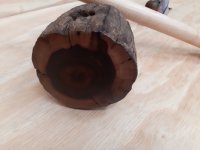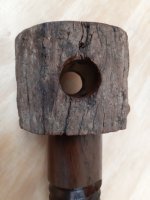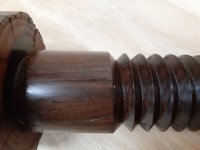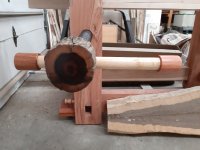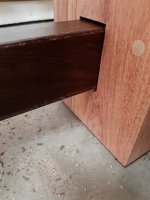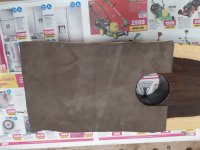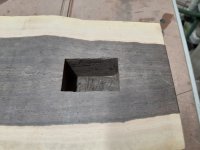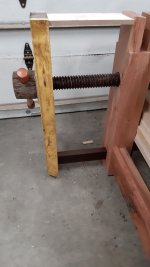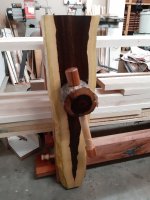I am busy building a Roubo workbench and have recently finished the screw for the leg vice. The screw is made from leadwood (an indigenous South African hardwood), the handle from maple and the handle knobs from African Rosewood. The diameter of the screw is 64 mm (around 2 1/2 inches), the hub is around 125 mm (5"), the handle is about 30 mm (c 1 1/4"). Overall length is 640 mm (just under 26 inches). The No 4 Stanley is added for scale.
[attachimg=1]
I had to build one custom jig for the internal threads and another router lathe for the external threads. A local engineering shop also made me a custom router bit for the internal threads.
The body of the screw was made from 70 x 70 mm square stock and turned to 64 mm diameter with a 50 mm tenon at the front end. It was then threaded. The hub was turned from a separate branch of the same type of wood (also leadwood) and a 50 mm hole drilled into the end. The main screw was then glued into the hub. A hole was then drilled and the handle added (the handle and knobs were also turned on the lathe).
I finished it with 3 coals of Danish Oil and then added Cobra floor polish to the threads to assist with smooth operation (that is the white you see on the photo - it makes a HUGE difference).
I must say, it turned out almost better than I thought! At one stage through the process I almost gave up, I tried a Beal type (Carter Whitling type) threading approach for the external threads but for some reason I just could not make it work...
I just need to edit my video a bit - will upload it once done and then you can see it in action.
Next up is the chop, will show it when done. EDIT 13 July 2020: The chop is now done, see the YouTube video in the comments below. PS: I have also made it "pinless" - have a look!
[attachimg=2]
[attachimg=3]
[attachimg=4]
[attachimg=5]
[attachimg=1]
I had to build one custom jig for the internal threads and another router lathe for the external threads. A local engineering shop also made me a custom router bit for the internal threads.
The body of the screw was made from 70 x 70 mm square stock and turned to 64 mm diameter with a 50 mm tenon at the front end. It was then threaded. The hub was turned from a separate branch of the same type of wood (also leadwood) and a 50 mm hole drilled into the end. The main screw was then glued into the hub. A hole was then drilled and the handle added (the handle and knobs were also turned on the lathe).
I finished it with 3 coals of Danish Oil and then added Cobra floor polish to the threads to assist with smooth operation (that is the white you see on the photo - it makes a HUGE difference).
I must say, it turned out almost better than I thought! At one stage through the process I almost gave up, I tried a Beal type (Carter Whitling type) threading approach for the external threads but for some reason I just could not make it work...
I just need to edit my video a bit - will upload it once done and then you can see it in action.
Next up is the chop, will show it when done. EDIT 13 July 2020: The chop is now done, see the YouTube video in the comments below. PS: I have also made it "pinless" - have a look!
[attachimg=2]
[attachimg=3]
[attachimg=4]
[attachimg=5]


